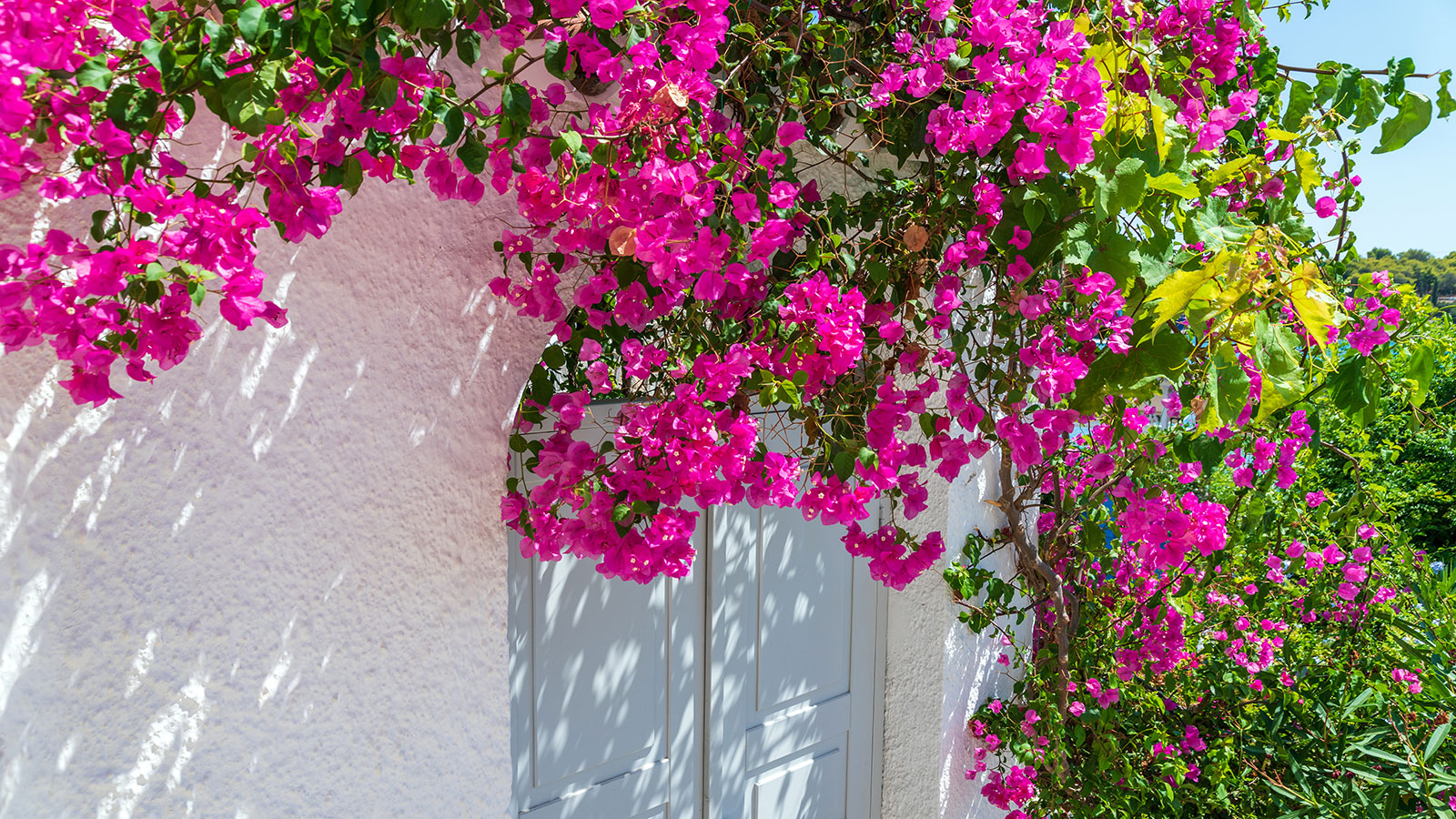
Bougainvilleas are among the most exotic looking plants you can grow. These bushy vines can be so prolific in flower that their vivid colors hide the leaves. Many are also vigorous in growth, but respond well to simple pruning.
Having said that bougainvilleas are hardy only to USDA Z9, in cooler zones they will not survive the winter outdoors. However, in areas where the winters are too harsh for bougainvilleas to survive outside, bougainvilleas can be grown in containers, pruned every year to restrict their size and moved into a frost-free environment as winter approaches.
There is no doubt that bougainvilleas are colorful climbing plants with flowers in orange, yellow, apricot, red, purple, magenta, pink and white. But look closely and you will see that the true flowers are small and white and the color is provided by what look like papery leaves that surround them. These are known as bracts. They are much more colorful and longer lasting than the flowers themselves, and provide the color that attracts pollinating insects. The fact that these bracts are long lasting adds enormously to the intensity of the delay.
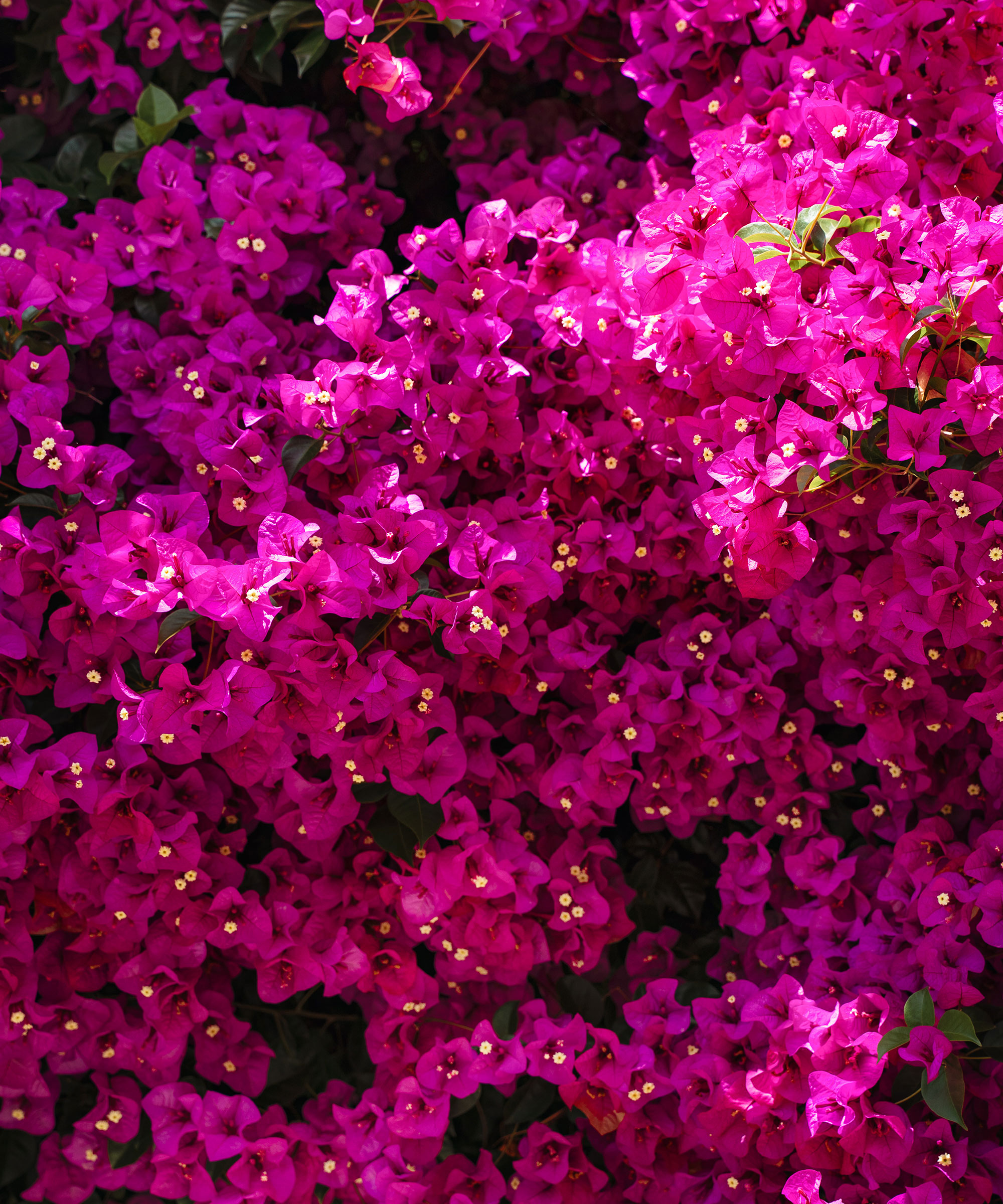
Bougainvilleas: key facts
- Plant type: Thorny, sprawling evergreen vine
- Mature size: 8-20ft+, depending on variety, fertilizing, climate and pruning
- Soil type: Well-drained
- Soil pH: Acid
- Situation: Full sun
- Time to plant: Spring, summer
- Flowering time: Spring, summer, fall
- Flower color: Orange, pink, purple, red, white, yellow and more
- Hardiness zones: USDA Z9
- Scientific name: Bougainvillea
- Common name: Bougainvillea
How to choose bougainvilleas for your yard
Choosing bougainvilleas is a simple matter. Have you the space for a traditional type that grows to a large size, or do you need a modern dwarf variety for a container? Which color of these flowering climbers do you prefer? Finally, do you need a variety with colorful leaves that looks attractive even when there are no flowers?
Bougainvilleas can be conveniently divided into four groups according to the size of the plants as they reach maturity – dwarf, semi-dwarf, medium-sized and large. They can also be divided into two foliage groups – most bougainvilleas have green foliage, but some have attractive variegated leaves.
- Dwarf bougainvillias Maturing at a height and spread of about 3-6ft, these varieties are ideal plants for hanging baskets, container gardening for the deck or balcony, small backyards where space is very limited, or for ground cover in relatively small spaces. Look for ‘Pink Pixie’ (pink flowers, chartreuse leaves, available at Fast Growing Trees), Sunvillea Series (pink, rose or yellow flowers, bushy growth), 'Yani's Delight' (cream and pink shades, superb in a hanging basket).
- Semi-dwarf bougainvilleas Reaching 6-10ft in height when mature, try one of these for large planters, as specimens in small and medium-sized yards, and for ground cover. Plants in this group are too large for hanging baskets. Look for 'Bengal Orange' (pinkish-orange flowers, variegated leaves), Golden Jackpot (‘MonSam’) (purple flowers, variegated leaves), ‘Miss Alice’ (white flowers, few thorns).
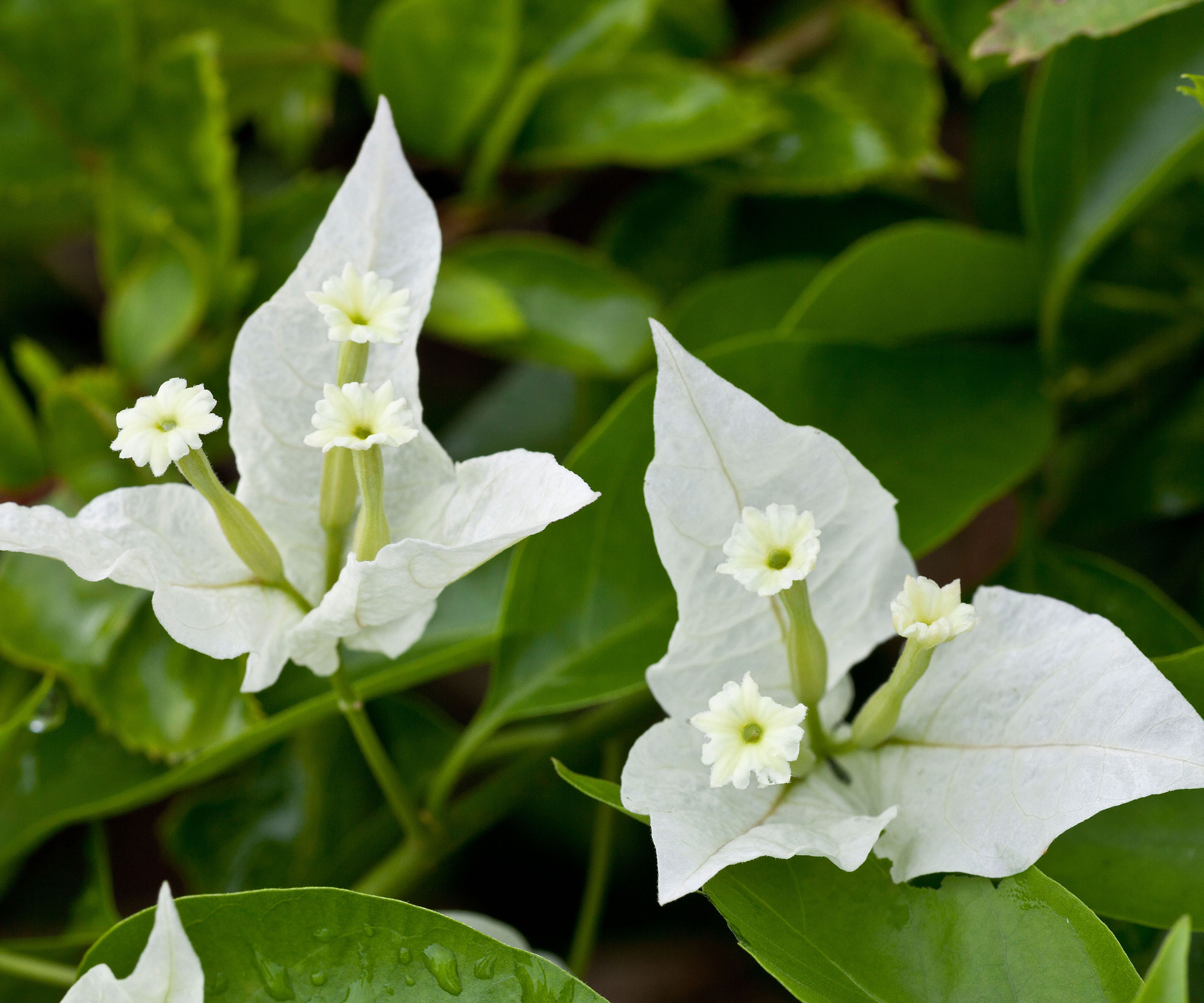
- Medium-sized bougainvilleas Maturing at 10-120ft, these impressive varieties make spectacular specimens in large gardens, as well as colorful impenetrable boundaries and are ideal plants to hide ugly walls and fences. Look for ‘Imperial Delight’ (pink shades, takes hard pruning), Purple Queen ('Moneth') (purple flowers, good ground cover), ‘White Stripe’ (white flowers, variegated leaves).
- Tall bougainvilleas These astonishing varieties are very vigorous and can reach more than 20ft in height, although they can be kept smaller with enthusiastic early spring pruning. Ideal scrambling over tumbledown buildings and other eyesores. Look for Camarillo Fiesta ('Monle') (unusual combination of pink and gold flowers), ‘Barbara Karst’ (hot pink flowers, very reliable, available from Fast Growing Trees), Gold Rush ('MONCliff') (sharp yellow maturing to gold).
- Variegated varieties Variegated bougainvilleas have yellow, cream or white margins to the leaves as well as colorful flowers. Look for ‘Blueberry Ice’ (rich, lavender-blue flowers, creamy white variegation, 3-4ft), ‘Bengal Orange' (pinkish orange flowers, creamy variegation, 6-8 ft), ‘Golden Jackpot’ (purple flowers, gold variegation, 6-10ft).
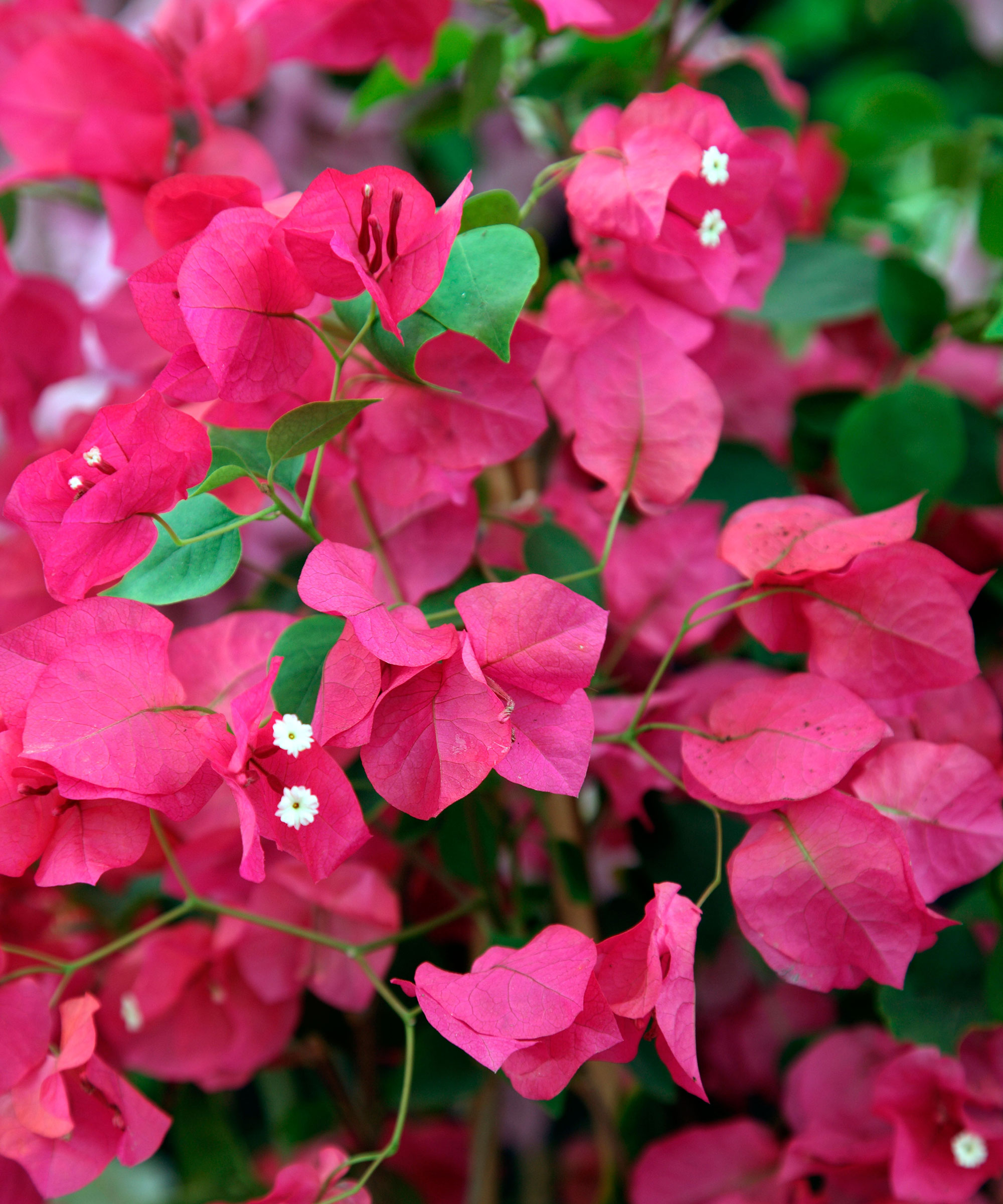
Where to grow bougainvilleas
Bougainvilleas will take a light frost, but generally need frost-free conditions so are ideal in USDA Zone 9 and above.
They will usually only grow and flower well in full sun, although in our warmest zones they will take a few hours of light shade. A site with good drainage is important, on a slope perhaps or in sandy or gravelly soil. Due to their vigorous scrambling growth they are best grown up robust supports, although if simply left alone many will spread into a tangle of tall ground cover.
For gardeners in Zone 8 and below, growing in well-drained potting soil in a container or planter box is ideal. The pot can then be moved into a frost-free place for winter protection.
Some gardeners in colder zones grow their bougainvilleas as annual plants, and buy a new plant each spring.
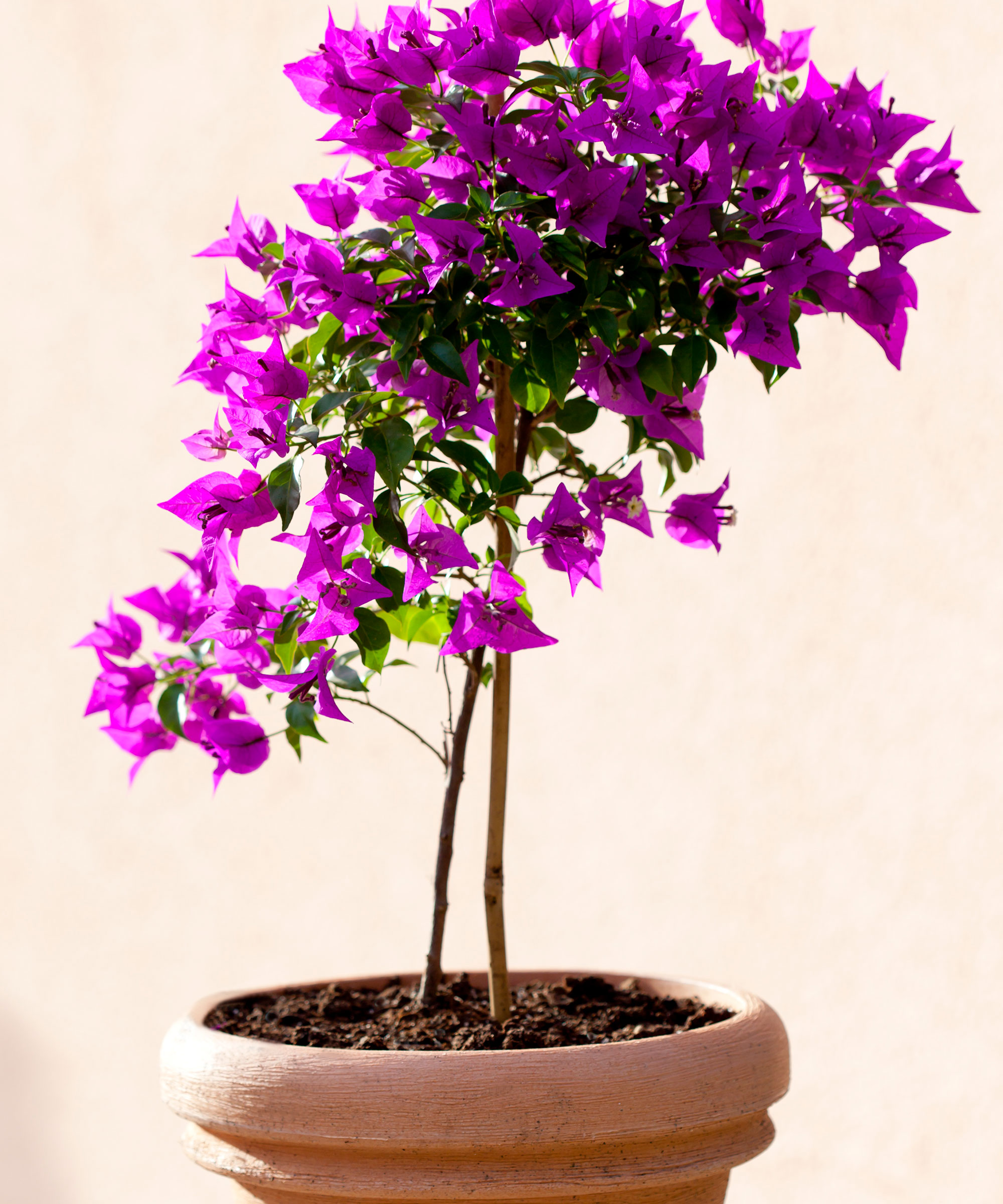
Planting bougainvilleas
Plant bougainvilleas in spring or early summer. The roots are a little delicate and easily damaged so do not loosen the roots in their potting soil. Simply dig a planting hole larger than the rootball, mix in some well-rotted garden compost or planting mix, then set your new bougainvillea in the hole, with the surface of the potting soil level with the surrounding soil. Fill in and firm gently.
Choose a site where these fast-growing flowering vines will have space to grow without smothering nearby plants and be sure to set them back from garden paths and gateways and decks to prevent accidental encounters with the thorns.
Care tips
Once bougainvilleas have settled in after planting, they need little care. They rarely need watering as they actively prefer dry conditions.
Fertilizing, however, is another matter. Bougainvilleas can only grow with their natural vigor if the plants are well fed. A regular treatment of a fertilizer specially formulated for bougainvilleas, such as Bougain, available on Amazon, is ideal.
Bougainvilleas usually flower well without pruning but you may need to reach for the pruners if your plants start to take up too much space or if there are dead or damaged branches that need removing.
After the main burst of spring flowering is the best time to prune. Pruning also stimulates fresh new growth and it is these shoots that will soon carry more flowers. Make sure you clean your pruning shears first, and beware of the thorns. Wear stout, long-sleeved gloves for protection, and do not lean into the bush too closely – better still, wear eye protection. Even sunglasses are better than no protection at all. These Acdyion gardening gloves from Amazon would be a suitable choice.
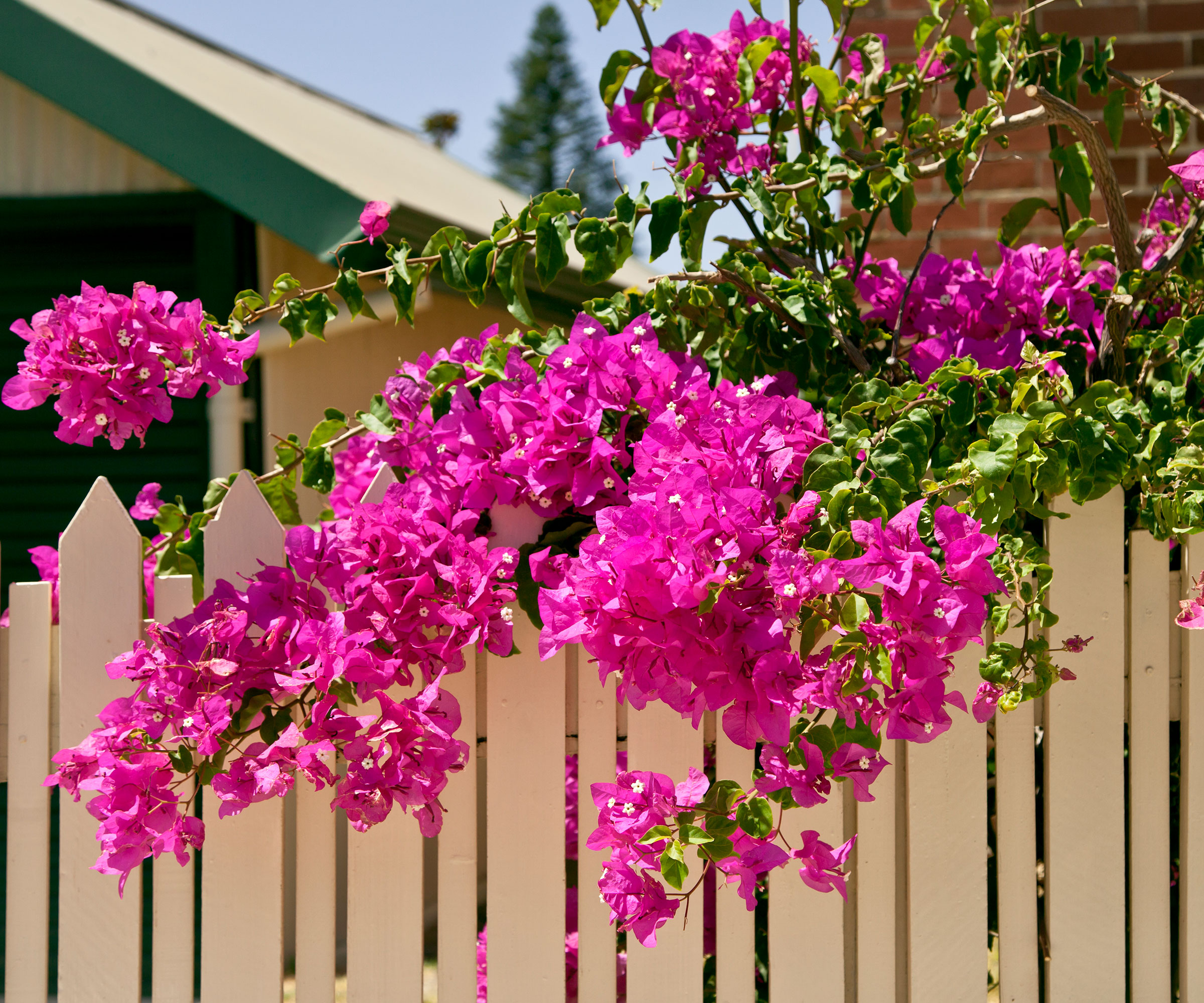
Making more bougainvilleas
The easiest and simplest way to make more bougainvilleas, though not the quickest, is layering.
In spring, look low down on the plant and find the tip of a branch growing near ground level. Clear away any weeds or mulch at the point at which the shoot touches the ground about 6-9in behind the shoot tip.
Scrape away some more dirt until the underside of the shoot touches the dirt about an inch deep. Cover with soil, firm with your hand, then place a large stone or brick over the buried shoot. This stops it moving and marks the spot. Then – do nothing.
By the fall, the shoot will have made roots and new growth should have developed at the tip. Follow the shoot from the tip back to just past the rooting point. Snip it off, dig up the rooted part and plant it in its new home.
Problems and how to solve them
Relatively few pests or diseases attack bougainvilleas. Prevention is always better than cure, so be sure not to encourage root rot by overwatering.
Shortage of nutrients, including minor nutrients that we all tend to forget about, can increase your bougainvillea’s susceptibility to diseases and also make the leaves turn pale.
Regular treatment with Bougain, which includes the right balance of major and minor plant nutrients for bougainvilleas, will keep your plant healthy and resistant to may problems.
Sooty mold can be found even on healthy plants and looks serious but is easy to deal with. This is a fungus that grows not on the leaves, but on the juice dropped by aphids, scale insects, mealybugs and other sap sucking insects on the leaves and stems above. Use an organic pest spray or make your own by mixing one tablespoon of liquid dish washing detergent into a gallon of water, stirring well and spraying on both sides of the leaves using a mister or garden sprayer.
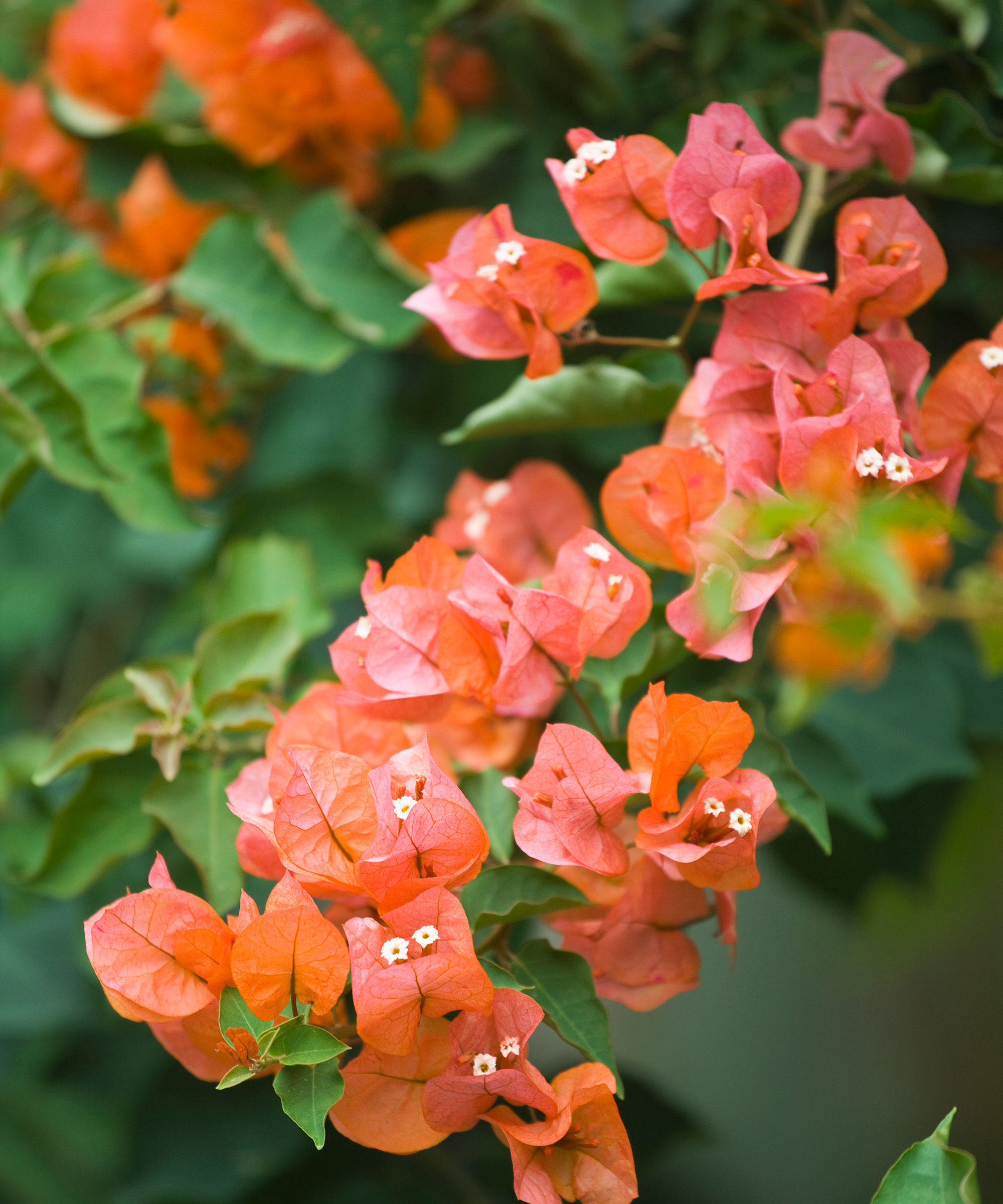
How to buy bougainvilleas
Buying by mail order will open up the widest choice of varieties, websites provide good images and simple texts describing the features of the different varieties.
Some nurseries sell quite small plants in 2 1/2in pots. These are the most economical as their light weight does not incur uncomfortable shipping charges. But you will have to wait for your new bougainvillea to reach a good size.
Plants in increasingly large sizes are also available – in effect, when you buy larger plants you are buying the time that the plant took to reach a larger size. Very large specimens are sometimes available, but check shipping costs carefully.
In areas where bougainvilleas grow well outside, USDA Z9 and above, you will also find bougainvilleas offered in the garden departments of DIY stores and by walk-in nurseries, more often in gallon, or two or three gallon, pots.
FAQs
Are bougainvilleas deer resistant?
Experience with bougainvilleas in California, Oregon and Florida indicates that, in general, they are deer-resistant plants and they won’t be eaten, but if other food is scarce deer will ignore the nasty spines and the distasteful leaves and feed on them.
As always, a deer fence is the best approach to preventing deer damage but, in warmer zones where bougainvilleas make large and vigorous plants, gardeners often tolerate a little deer browsing.
How do you overwinter a potted bougainvillea in Zone 7?
Bougainvilleas in planters can be overwintered in any frost-free place, even in the dark. A garage or a basement is ideal, but it must be frost free. Water only every three or four weeks, so the plant does not become completely parched. All the leaves will drop off, but the plant will remain dormant – and alive.
In spring, move your bougainvillea to somewhere bright, but still frost free. A sun room is often ideal. Water more often, and as the first green shoots of growth begins, fertilize with a liquid bougainvillea feed.
After the last frost, move your plant outside.
Are there any thornless bougainvilleas?
Yes, there are a few thornless bougainvilleas, but not very many. These are ideal if you have kids running about your yard and most are relatively dwarf in growth. Look for: ‘Miss Alice’ (white flowers, 6-10ft), ‘Silhouette Lila’ (lilac flowers, 6-8ft) and ‘Vera Deep Purple’ (purple flowers, 2-3ft).
Bougainvilleas enjoy dry, frost-free conditions and plenty of sunshine so will thrive in situations that are unsuitable for many other vines and shrubs. They do not insist on being pruned regularly and will flower well even if never pruned.
Smaller varieties are also good plants for pots, and they will not complain if you miss watering once in a while.







